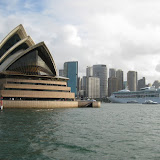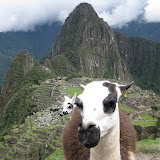
I sat on top of a forested hill overlooking the city of Hangzhou, a view of the beautiful West Lake peeking through the trees. I was flipping through my China guidebook, getting ideas for what I wanted to do for the next few days leading up to the total solar eclipse next week. I happened to be sitting next to a tall pagoda-- that's where the benches were. Two Chinese guys, maybe nineteen or twenty, came up the path and approached me to practice their English. We chatted for a little bit, and when there was a lull in the conversation, I looked around for inspiration. That's when I noticed something odd poking out from the trees of the forest.
“Is that a security camera?” I asked.
“No” Some quick conferring in Chinese “Yes. Yes, that is camera.”
It looked like one of those cameras next to traffic lights that take pictures of people's license plates after they run a red light.
“What's it there for?” I asked.
“Fair.”
“Uh, what?”
“Fair warning.”
“Oh.”
Well, I thought, that's kind of them... fair warning for what, exactly?
China sometimes feels like an exercise of the “which of these things does not belong in this picture.” I hadn't realized it until I sat down and thought for a bit, but it's been an eye-opening visit. Most of what you read is controlled by the government in some way, shape, or form. It doesn't feel nearly as controlling, patronizing or overbearing big-brother-is-watching as I expected it to be. But it is definitely there if you're looking. Just like in Singapore, this means that you learn just as much from what's missing as you do from what's there. All over Hangzhou is gorgeous Chinese architecture, mostly in the form of tourist sites at this point, crowded around by loud groups of Chinese and Japanese amateur photographers following someone with a bullhorn walking backwards waving a brightly-colored flag on a stick. If you read the signs next to the pagodas, stone tablets, gates, and other artifacts, you'll notice a common theme: built during the Song dynasty, destroyed in the late 60s, rebuilt in the 80s. Often the date of destruction is omitted. No explanation of this mass destruction of historical and cultural artifacts is offered.
The untold explanation surfaces when you look up what was happening during the ten years everything was ripped up: Chairman Mao's Cultural Revolution. In 1966, Mao Zedong (or Tse Tung depending on when your history book was published) staged a coup against his own communist party calling for a overthrow of all the other communist party leaders. Things got violent fast, and across the country, an unimaginable amount of 3000+ year-old heritage was ripped apart. After Mao's death and the succession of Deng Xiaoping, people began to restore some of what was lost. Or tried to.
I'm writing this from the city of Nanjing, one of the few cities that has kept its Ming-era city walls. Or most of it. Beijing, Xian, and Shanghai all lost their ancient city walls (though I don't know the story behind the destruction of each). I went to see one of the gates. It's the biggest on the the city had. The wall continues on either side for about twenty yards and then it ends. There's more to the wall than that in other parts of the city, but seeing that little piece of what was once a mighty Ming dynasty historical testament drives home just how much this country has lost.
What it's lost, it's moving hard to make up for in new stuff. Shanghai looks like someone dropped an enormous alien magnet designed to attract all skyscrapers for a mile radius. The third-tallest building in the world rises next to one almost as tall with, with a large square opening near the top about about ten stories high. I don't know what the intended effect was, but it looks like a gigantic bottle-opener. From the top, you can count the helicopter pads on top of the dozens of other skyscrapers thronged around the Pudong side of the river.
Half the town is under construction, including the historical lake walk known as The Bund. The 2010 world's fair is coming, and Shanghai wants to be ready. The effect is a huge, dusty city that is one half concrete, one quarter steel and glass, and one quarter scaffolding and construction equipment. High rise apartment buildings sprout from the concrete like weeds from a parking strip (and if you've ever seen the parking strip in front of my house, you'll know how impressive this must seem).
The Shanghai Museum protects some of the oldest things I'd ever seen. Pottery and sculpture casually dated from the 13th century, BC. I read that it has pieces much older than that. It's a beautiful collection of art, artifacts, and archeology, free of charge for anyone who has the patience to stand in line behind the metal detectors. Don't bring a laptop, they're not allowed inside.
I could go on for a long time about all the images I've been seeing. The mall full of eyeglass stores, for example. I got to the top floor of a mall and walked for ten minutes without backtracking past nothing but store after store selling prescription glasses and frames. Just imagine what shopping for anything else is like. The stores are clean and modern, the city streets are lined with designer shops. The high-speed trains run over 230 km/h (that's just the ones I've ridden so far), and everything feels pretty modern. In the city center.
Then I took a train from Shanghai to Hangzhou east train station, and I was back in the third world. Dirt roads, trash everywhere, cardboard signs, hawkers and touts, rust, and corrugated tin buildings. Then I got on a bus with a TV in the front and rode back into the tree-lined avenues with KFC sandwiched between Cartier and Dolce & Gabana. I remember seeing mansions in the middle of slums in India. Outright opulence loudly sitting right next to outright squalor with nothing hidden from either side. But in China, it's whole sections of towns that have squirreled themselves away from each other, completely hidden. You'll be walking down a developing world alleyway with peeling paint, potholes, and the ubiquitous fat shirtless men on stools sitting and watching the street in every developing nation in the world. Then you'll turn a corner, walk past a construction site and all of the sudden you're dodging sports cars and taxicabs in a sparkling modern metropolis and have no idea what magical portal you just walked through or where the fruit carts with busted axles just went and who replaced them with bubble-tea stalls.
My favorite experience so far was removed from all this. I was sitting in the apartment of some couchsurfers after a mouthwatering $1.25 dinner of home-made noodles (as in we watched the chef whack the dough on the table and pull it into individual noodles by hand before tossing it out the window into the boiling oil they were cooked in), and our host pulled out a tea set. This is not your little sister's take-the-dolls-out-for-a-tea-party set. This was the classic Chinese wood and pottery tea ceremony set. It became an informal tea ceremony-- the second I'd ever had (the first being with my host in Malaysia, the Chinese tea master). Though Jenny, our host, made a big deal about how there was really no one right way of doing this, there were clearly more protocols than I usually followed with tea. Each tea was served in the correct order, the water was heated to the right temperature, it was steeped the right number of seconds, and served into the correct type of cup. The first round was always disposed of without drinking. It was half wine tasting, half spiritual ceremony, though there was nothing religious involved. Little snacks kept appearing out of nowhere, from wasabi-coated dried lotus seeds to spicy, tomato-flavored Cheetos.
Something interesting happened. As we all sat there, going through the rituals, and sipping our tea, the conversation became a lot deeper. Politics came up, as did educational styles between different cultures, and the effect they have on each society, and how they relate to each other. Something about the tea ceremony brought that all out. The first tea ceremony I'd been to had the exact same effect on the conversation-- I was sure that if the same group been out drinking beer, we'd have been talking about movies or cracking jokes about whoever else was in the restaurant or bar.
And yes, I've had those nights too. Last night I spent in a bar listening to a Filipino cover band play Juanes while sitting with a British illustrator, her twin sister the foreign language student, their brother the law student, an actor from LA, and a Texan mining supervisor who kept buying us all drinks. In China. As this is what I think of as the tame side of my travels.
If my rambling on about one thing after another in this entry is interesting, confusing, and random, then you're getting a good feel of how this country makes me feel so far.
While I'm on the subject of *random*, if any of you have any connections to an employee of a Russian consular office in Shanghai, Beijing, Seoul, Tokyo, or Ulaanbaatar, do me a big favor and email me.
---
Check out this entry's Photos.








I'd love to visit the Shanghai Museum some day. Ah, antiquities. Although the cynic in me wonders if any of THEM are "destroyed 1960s, remade 1980s".
ReplyDeleteI'm interested by your description of how the rich/poor contrast is between rather than within neighborhoods in China. Is that true in all the cities you've been in, or mostly Shanghai?
ditto Count C's question. Anonymom.
ReplyDelete